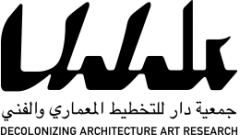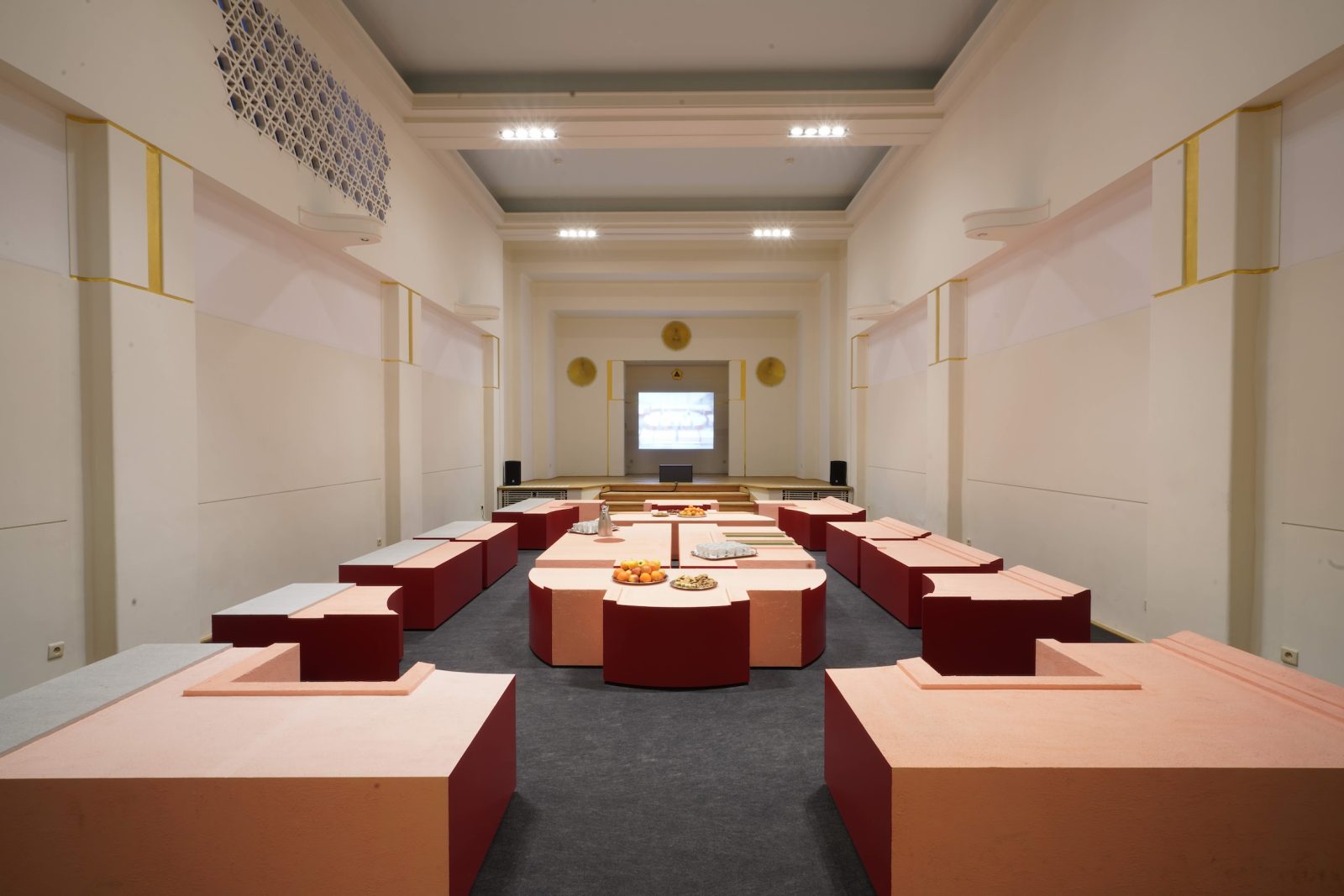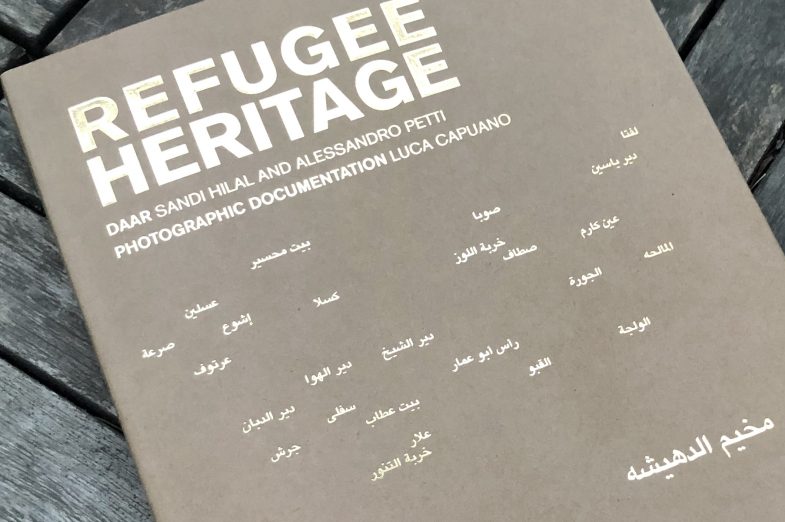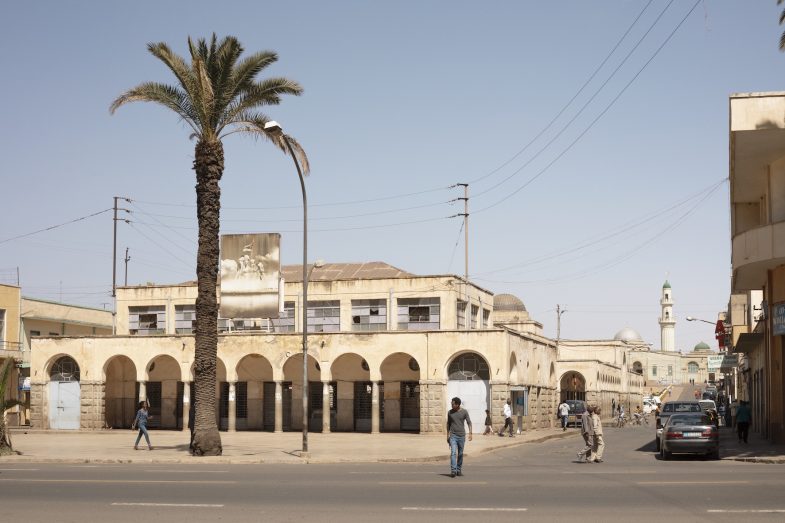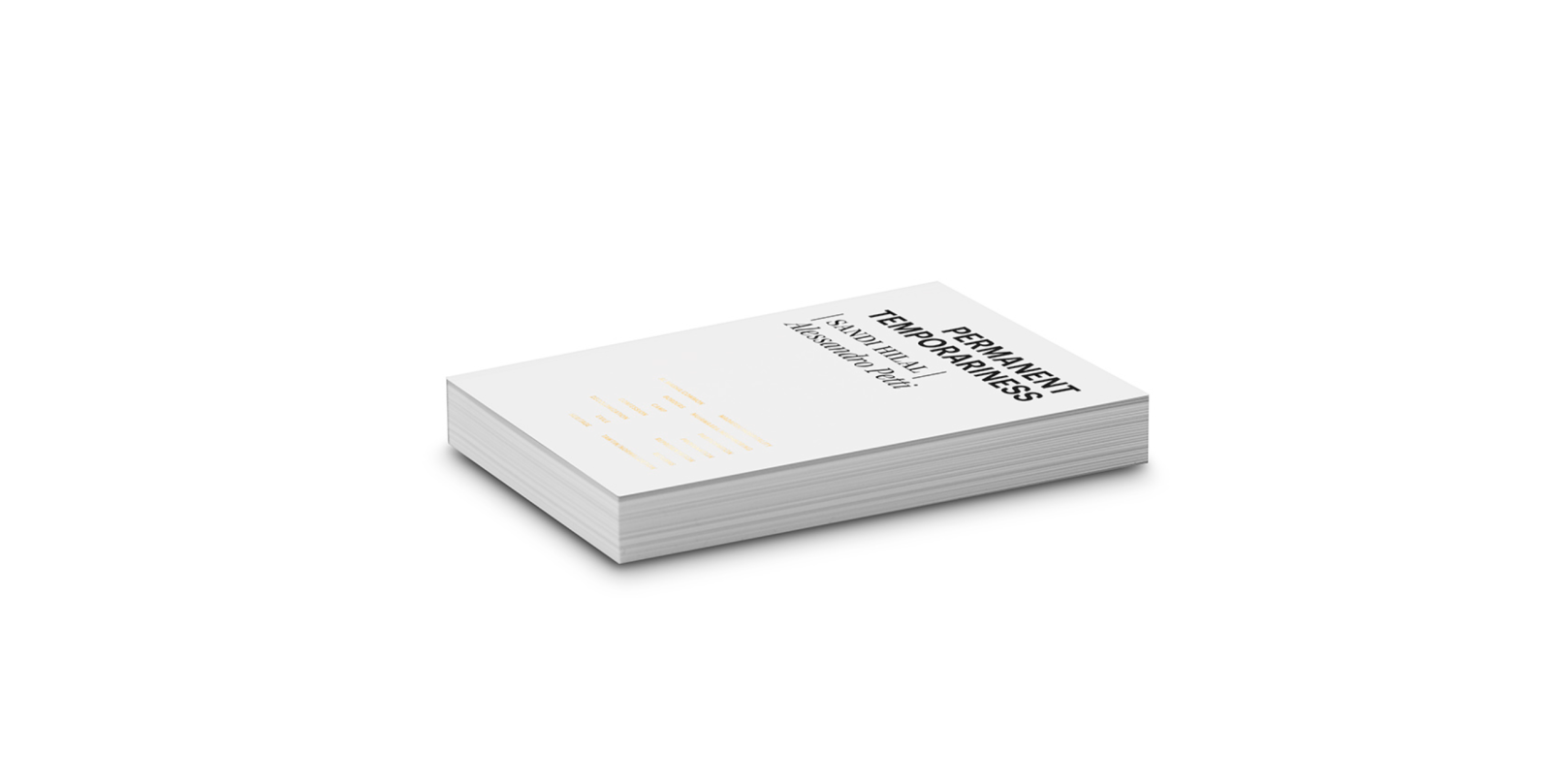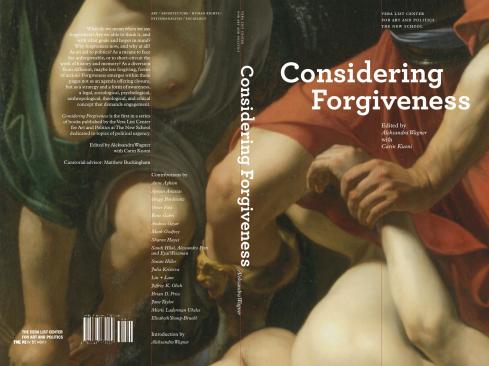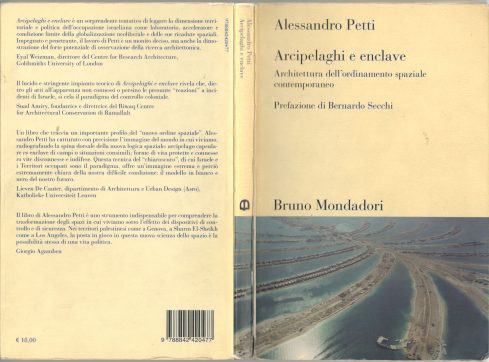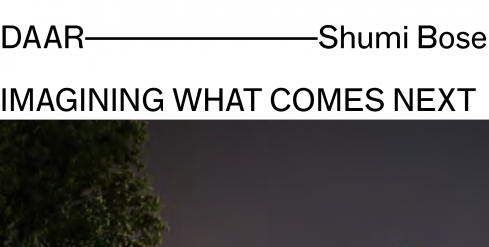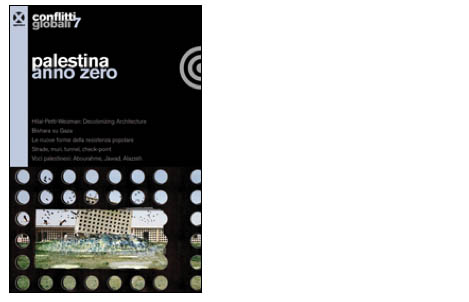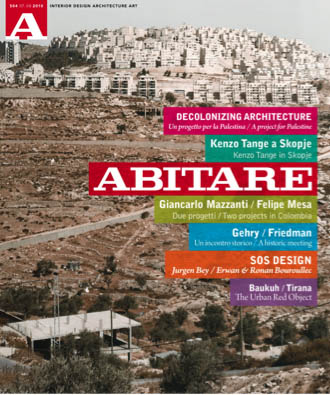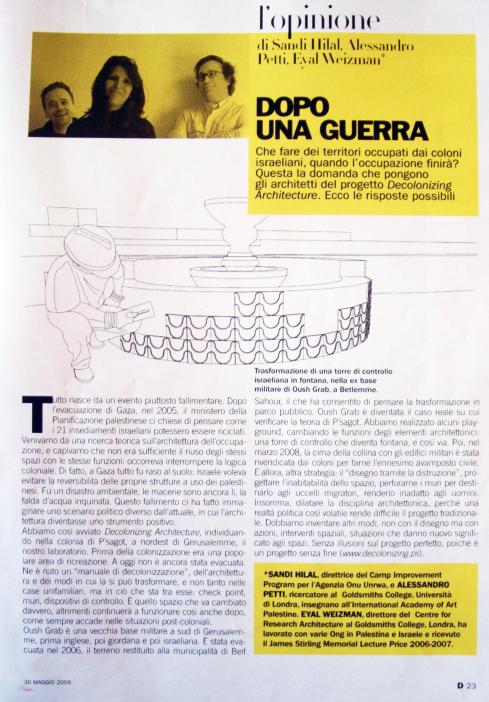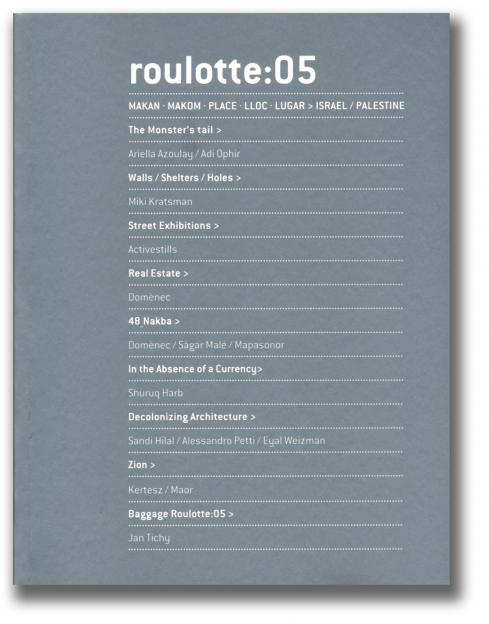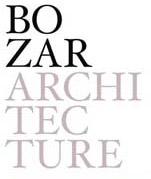DAAR in Practice
The Architectural Review, ISSUE 1510, APRIL 2024 (pag.26-29)
AR_2024_04_026-029_IN PRACTICE_DAAR_Sandi-Hilal_and_Alessandro-Petti
“Exhibition as Site of Transgression: An Interview with Sandi Hilal and Alessandro Petti (DAAR – Decolonizing Architecture Art Research)” Alessandro Paolo Lena in Exhibited Thoughts of Architecture, Edited by Anna Rossellini, MM Journal of Museum Studies, Vol. 1, No. 1 – 2024, pp. 097-115
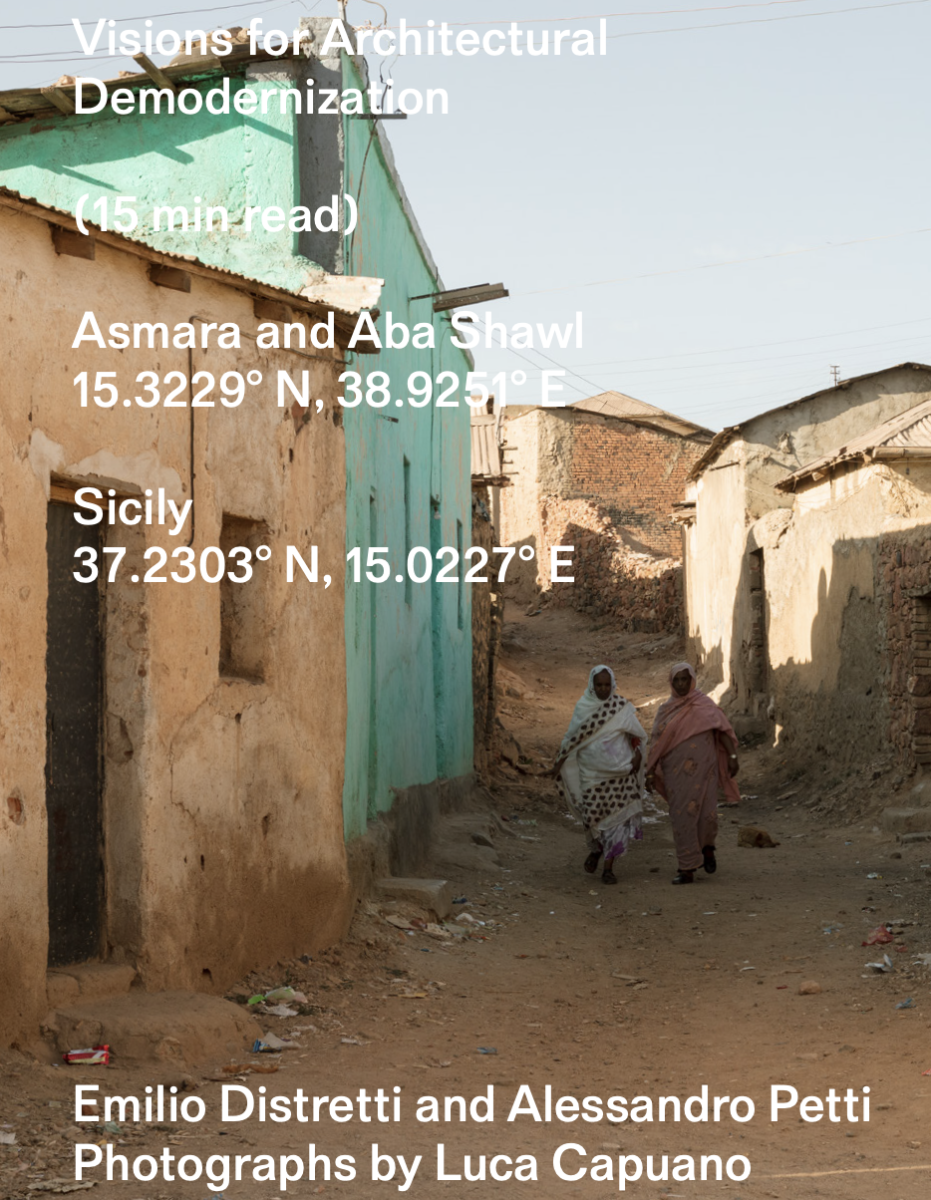 VISIONS FOR ARCHITECTURAL DEMODERNIZATION
VISIONS FOR ARCHITECTURAL DEMODERNIZATION
By Emilio Disretti and Alessandro Petti
Photographs by Luca Capuano
in
forA on the Urban Issue #1
march 2023, Birkhäuser
THE CREATION OF LEARNING ENVIRONMENTS
Alessandro Petti
in
eflux education
Survey, April 2023
https://www.e-flux.com/education/features/534861/survey-alessandro-petti
TREE SCHOOLS
Sandi Hilal & Alessandro Petti (DAAR) in conversation with WHW
in
Artistic Ecologies
New Compasses and Tools
Edited by Emily Pethick, Pablo Martínez and How & for Whom/WHW What
Sternberg Press 2022
Tree Schools_Artistic Ecologies_spreads small
THE PERMANENT TEMPORARINESS OF HERITAGE
Sandi Hilal & Alessandro Petti in conversation with Lucia Allais
in
Harvard Design Magazine #50: Today’s Global
Edited by Sarah M. Whiting and Rahul Mehrotra
May 2022
DAAR – HILAL S., PETTI A., “Refugee Heritage”, Art and Theory Publishing 2021
This book-dossier attempts to deactivate the claims of objectivity and universalism contained in the conventions followed by UNESCO in determining World Heritage status; it presents different narratives that do not fit within such statist discourse, reorienting heritage towards non-hegemonic forms of life and collective memory. By reusing, misusing and redirecting UNESCO World Heritage guidelines and criteria, Refugee Heritage challenges definitions of heritage and their colonial foundations, asking instead how architecture is mobilized as an agent of political transformation.
Authors: Sandi Hilal, Alessandro Petti
Photographic documentaion: Luca Capuano
Texts by: Suad Amiry, Foad Al-Laham, Muhammad Khalil Al-Laham, Khaldun Bishara, Ilana Feldman, Sari Hanafi, Ismae’l Sheikh Hassan, Osama Jafari, Thomas Keenan, Elias Khoury, Jorge Otero-Pailos, Paul B. Preciado, Nasser Ramadan, Rasha Salti, Jad Tabet, Pelin Tan, Eyal Weizman
Design by: Matthew Ashton and Mauro Bubbico with assistance from Fabio Bacchini, Giacomo Dal Prà, Alessandro Latela, Luca Longobardi
2021, English, Arabic, softcover
328 pages, 22 x 30 cm
ISBN 9789198606591
REFUGEE HERITAGE PRELUDE (pp.01-pp45)
REFUGEE HERITAGE ARABIC (pp.268-pp328)
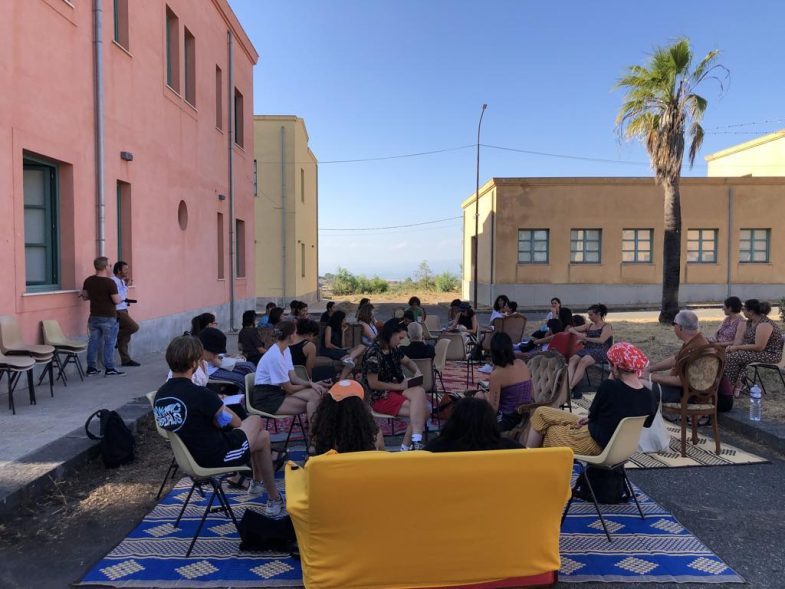
In the epoch in which we write and speak from the southern shores of Europe, the entanglement of demodernization with decolonization is not a given, and certainly does not imply an equation. While decolonization originates in – and is only genealogically possible as the outcome of – anti-colonialist struggles and liberation movements from imperial theft and yoke, demodernization does not relate to anti-modernism, which was an expression of reactionary, anti-technological and nationalist sentiment, stirred at the verge of Europe’s liberal collapse in the interwar period. As Dolci explained for the Italian and Sicilian context, there is no shelter to be found in any anachronistic escape to the (unreal and fictional) splen- dours of the past. Or, following Gramsci’s refusal to believe that the Italian South would find the solutions to its problems through meridionalism, a form of southern identitarian and essentialist regionalism, which further detaches ‘the Southern question’ from possible alliances with the North.
Emilio Distretti and Alessandro Petti
Architectural Demodernization as Critical Pedagogy
Architectural Demodernization as Critical Pedagogy-pdf
in Architectural Dissonances, Published by www.internationaleonline.org, December 2021
On July 8, 2017, during the first session of the UNESCO World Heritage Committee in Krakow, the capital of Eritrea, Asmara, was declared a UNESCO World Heritage site. The winning application, titled “Asmara—Africa’s Modernist City” refers to the modernist fascist-colonial architectural and urban transformation of Asmara that occurred during the Italian colonial occupation (1890–1941). The nomination and its inscription were the culmination of a long project of documenting and cataloging of more than four thousand modernist buildings begun since Eritrea’s independence from Ethiopia in 1991.
The listing of Asmara as UNESCO World Heritage Site is an unsettling story that has raised a series of contradictory questions around the outstanding issue of colonial heritage: does the nomination constitute a new chapter in the Eritrean national struggle for liberation and self-determination? Does it mark the conclusion of a long path of decolonization from fascism marked by the reuse and reappropriation of colonial buildings and infrastructure? Or, on the contrary, is it a postideological and economic initiative that aims to revive the bygone “colonial times” for Western tourism? Is Asmara’s inscription within UNESCO criteria an act of submission by non- European cultures and civilization to European universalistic, colonial, and Eurocentric values?
While acknowledging the impossibility of separating those questions and rejecting the objective of offering neat and comfortable solutions to these dilemmas, we recognize that Asmara’s nomination exercises an unsettling power, as it reunites ex-colonizing and ex-colonized societies around common questions: Is there an afterlife of fascist colonial architecture? Is there a possibility for its reuse without falling into the celebration of fascist ideology? What kind of heritage really is fascist colonial architectural heritage?
Emilio Distretti and Alessandro Petti
The Afterlife Colonial Fascist Architecture. A Critical Manifesto
Future Anterior
Volume XVI, Number 2 Winter 2019
The term decolonize has gained a new life in recent art activism, as a radical challenge to the Eurocentrism of museums (in light of Native, Indigenous, and other epistemological perspectives) as well as in the museum’s structural relation to violence (either in its ties to oligarchic trustees or to corporations engaged in the business of war or environmental depredation). In calling forth the mid-twentieth-century period of decolonization as its historical point of reference, the word’s emphatic return is rhetorically powerful, and it corresponds to a parallel interest among scholars in a plural field of postcolonial or global modernisms. The exhortation to decolonize, however, is not uncontroversial—some believe it still carries a Eurocentric bias. Indeed, it has been proposed that, for the West, de-imperialization is perhaps even more urgent than decolonization.
What does the term decolonize mean to you in your work in activism, criticism, art, and/or scholarship? Why has it come to play such an urgent role in the neoliberal West? How can we link it historically with the political history of decolonization, and how does it work to translate postcolonial theory into a critique of the neocolonial contemporary art world?
—Huey Copeland, Hal Foster, David Joselit, and Pamela M. Lee
What does it mean to decolonize?_Alessandro Petti
A Questionnaire on Decolonization, October, NO. 174, Fall 2020
HILAL S., PETTI A., “Permanent Temporariness”, Art and Theory 2019
Since their first work, Stateless Nation at the Venice Biennial in 2003, and throughout their more recent architectural interventions in refugee camps, the artistic practice of Sandi Hilal and Alessandro Petti has explored and acted within and against the condition of permanent temporariness that permeates contemporary forms of life. In their ambitious research and project-based practice, art exhibitions are both sites of display and sites of action that spill over into other contexts: built architectural structures, the shaping of critical learning environments, interventions that challenge dominant collective narratives, the production of new political imaginations, the re-definition of words, and the formation of civic spaces.
This book is organized around fourteen concepts that activate seventeen different projects. Each project is the result of a larger process of collaboration and is accompanied by individual and collective texts and interviews that contextualize and expand the reach of every intervention.
Contributors to projects and texts include Maria Nadotti, Charles Esche, Robert Latham, Salwa Mikdadi, Eyal Weizman, Okwui Enwezor, Munir Fasheh, Grupo Contrafilé, Murad Odeh, and Rana Abughannam. Edited by Maria Nadotti and Nick Axel, co-published by the Royal Institute of Art, Sweden. The publication of this book has been made possible with the generous support of the Royal Institute of Art, Stockholm; New York University Abu Dhabi Art Gallery; Van Abbemuseum; and the Foundation for Arts Initiatives.
PETTI, A., “Archipelagos and enclaves: On the border between Jordan and Palestine-Israel”, in Architecture on the Borderline edited by Anoma Pieris, Routledge 2019
The archipelago is a system of connected islands; enclaves are simply islands; it can accommodate both legal and illegal flows inside its space, whereas enclaves have no type of connection: they are isolated by forms of power that may be internal or external to them, a power they submit to or which they exert. There is a substantial difference between being enclosed and enclosing oneself: it is what distinguishes a concentration camp from a luxury community.
PETTI, A. “Refugee Heritage. Part III Justification for Inscription”, in the journal of Humanities 2017, 6(3) humanities-06-00066
The camp has an undisputable origin in the Nakba of 1948 and the forty-four villages families were relocated from. The original urban structure of the camp was a military-like grid adapted to the topography. Without municipal involvement and state governance, residents were largely left to determine the evolution of their urban environment according to the values they themselves willed. Over time, the grid has been modified, contested, and absorbed by the lives of its inhabitants. In adapting to urban conditions, unique systems of civic management were developed to preserve elements of the rural cultures residents brought with them.
PETTI, A., “Campus in Camps: knowledge production and urban interventions in refugee camps”, in The Routledge Companion to Planning in the Global South, 2017
Taking Campus in Camps as case studies in the following pages I’ll try to answer to some of the following questions: which role has the university in the greater transformation of society? How the knowledge that is produced inside its walls could be relevant, useful for students that live in marginalized communities? What kinds of structures or institutions are required for the accommodation of interests and subjects born from the interaction between students, teachers and the broader social context? How can the attention of educational institutions move from the production of knowledge – based on information and skills – to processes of learning – based on shifts in perception, critical approaches, visions and governing principles? And how to reconcile theory with action, and combine a rigorous understanding of the problems with pragmatic and effective urban interventions?
Knowledge production in Refugee Camps
HILAL S. “Roofless Plaza“, in Housing after the Neoliberal Turn: International Case Studies, 2015
Camps are political spaces and their built environment is a symbol of political struggle. How can one build an open public space in an exceptional environment where the concept of public and private doesn’t exist? Where any urban elements that resemble those of a city threatens the temporality of the camps and therefore is seen as jeopardizing the refugees right of return? This has been a dilemma plaguing the refugees since they were forced to replace their tents with houses.
.
.
HILAL, S. “Abu Ata, Architect: a play in four act” in “Architecture is All Over” ed. Marrikka Trotter and Esther Choi, (2016)
May, 2008. An open space about seventy square meters in area in a crowded neighborhood of the Fawwar Refugee Camp in the West Bank. The ARCHITECT sits on a chair in the center of the space, turned to her left to face a group of about twenty women of all ages, who are sitting in chairs or on the ground. They include HADIYAH, AMEENAH, HALAH, HAJAH SALMA, and JAMILAH. To her right, a group of about the same number of men, also of all ages, but with a large proportion of young men, or shabab, sits or stands silently. They include AHMED, ABU RABIAH, and ABU RAMI. A shader, or cloth canopy covering, protects everyone from the sun.
.
.
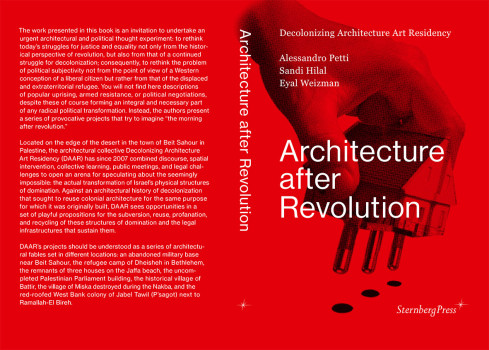
PETTI A., HILAL S. WEIZMAN E., “Architecture after adervolution”, Sternberg Berlin 2013
The work presented in this book is an invitation to undertake an urgent architectural and political thought experiment: to rethink today’s struggles for justice and equality not only from the historical perspective of revolution, but also from that of a continued struggle for decolonization; consequently, to rethink the problem of political subjectivity not from the point of view of a Western conception of a liberal citizen but rather from that of the displaced and extraterritorial refugee. You will not find here descriptions of popular uprising, armed resistance, or political negotiations, despite these of course forming an integral and necessary part of any radical political transformation. Instead, the authors present a series of provocative projects that try to imagine “the morning after revolution.”
.
.
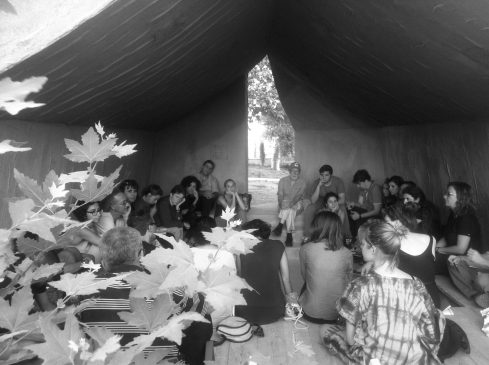
PETTI, A., “Decolonizing Knowledge”, Archis N. 3, 2015
In 1987, in an attempt to suppress the intifada (the Palestinian civil protests against its military occupation) the Israeli government banned people from gathering together and closed all schools and universities. As a reaction, Palestinian civil society grew through the organization of an underground network of schools and universities in private houses, garages and shops. Universities were no longer confined within walls or campuses, and teachers and students began using different learning environments in cities and villages. These gatherings and assemblies reinforced the social and cultural life of Palestinian communities. Learning was not limited to the hours spent sitting in classrooms; mathematics, science, literature and geography were subjects that could be imparted amongst friends, family members and neighbors. In order to resist the long periods of curfews imposed by the Israeli army, these self-organized spaces for learning included self-sufficiency activities such as growing fruits and vegetables and raising animals. Theoretical knowledge was combined with one that emerged from action and experimentation. Learning became a crucial tool for gaining freedom and autonomy. People discovered that they could share knowledge and be in charge of what and how to study.
.
.
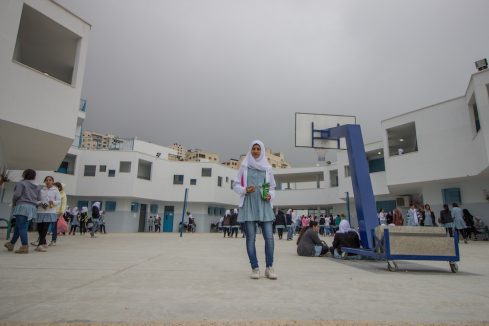
PETTI, A., “School in exile”, Archis, Archis N. 3, 2015
Since the first appearance of Palestinian refugee camps after the Nakba, the Arabic term that indicates the exile of two-thirds of the Palestinian population in 1948, their architecture was conceived as a temporary solution. The first pictures of refugee camps showed small villages made of tents ordered according to grids used for military encampments. As the years passed and no political solution was found for the plight of the displaced Palestinians, tents were substituted with shelters in an attempt to respond to the growing needs of the camp population without undermining the temporary condition of the camp, and therefore undermining their political right of return. However, with a growing population, the condition in the camps worsened. The precariousness and temporariness of the camp structure was not simply a technical problem, but also the material-symbolic embodiment of the principle that its inhabitants be allowed to return as soon as possible to their place of origin.
Thus, the camp becomes a magnetic force in which political powers try to exercise their influence, and the refugee community vehemently opposes any attempt to normalize it. Every single banal act, from building a roof to opening a new street, is read as a political statement on the right of return. Nothing in the camp can be considered without political implication.
.
.
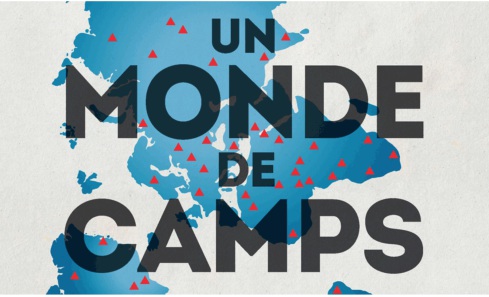
HILAL S., PETTI A., WEIZMAN E., “Dheisheh (Cisjordanie). Retours. Penser le futur dans l’extraterritorialité (un projet architectural)”, in, Michel Agier (dir.), Un monde de camps, Paris, La Découverte, 2014, 350 p., ISBN
Les camps se multiplient et se banalisent partout sur la planète. Ils sont aujourd’hui des milliers, dessinant peu à peu un nouveau paysage mondial. Gouvernements nationaux et agences internationales adoptent de plus en plus systématiquement cette solution pour ” regrouper ” les réfugiés humanitaires, pour ” parquer “, faire ” transiter “, ” retenir ” ou mettre à l’écart les ” déplacés ” et les migrants, les ” clandestins ” et autres indésirables. Douze millions de personnes vivent ainsi dans ces camps, des millions d’autres dans des campements de fortune, au creux des forêts, dans les interstices des villes, le long des frontières ; d’autres encore sont piégées dans des centres de rétention, des zones d’attente ou de transit. Si ces ” hors-lieux ” sont des espaces de parias, nombre d’entre eux s’inscrivent dans la durée et se transforment au fil du temps : la vie s’y renouvelle, s’y attache, et l’emporte le plus souvent sur la mort ou le dépérissement. En vingt-cinq monographies qui forment une sorte de tour du monde des camps (du plus ancien, à Chatila au Liban, au plus grand, à Dadaab au Kenya, qui regroupe 450 000 habitants, en passant par le plus informel, à Canaan en Haïti, ou le plus précaire, à Calais), cet ouvrage fait découvrir la vie intime et quotidienne de leurs habitants. Loin d’être l'” exception ” que l’on évoque généralement dans un cadre humanitaire ou sécuritaire pour en justifier l’existence, les camps font durablement partie des espaces et des sociétés qui composent le monde aujourd’hui.
.
.
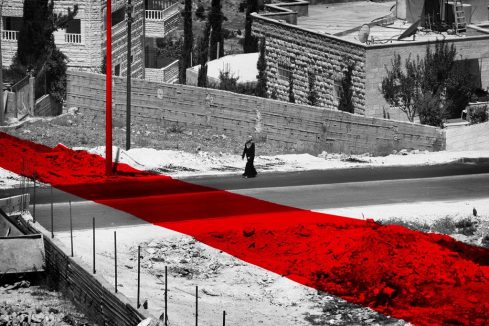
HILAL S., PETTI A., WEIZMAN E., PERUGINI N., “The lawless line”, Oxford Journals Law London Review of International Law Volume 1, Issue 1Pp. 201-209 (March 2014)
The various historical plans for partitioning Palestine – from the 1937 Peel Commission Report to the 1993 Oslo Accords – not only divided the land into non-contiguous territories, they also gave rise to a new spatial condition. Between the various territories another space emerged, whose expanse was the very width of the lines separating them. Each partition line reflected the particular cartographic technologies and political conditions of the time, its size a function of the scale of the map on which it was drawn
.
.
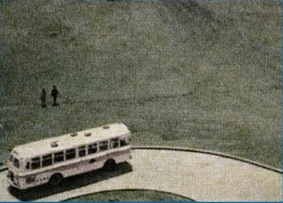
HILAL S. PETTI A., “Reimagining the Common: Rethinking the Refugee Experience”, in The Human Snapshot, Thomas Keenan, Tirdad Zolghadr (Eds.), Sternberg April 2013
“Universalism” and “humanism” are monolithic terms that do not lend themselves to easy definitions. We propose to think of universalism essentially as the perpetual search and redefinition of what we as human beings have in common. So the question is: what is the common? We interpret the common as “ordinary” and “universal.” Rather than the term “commons,” more familiar in the Anglo-Saxon tradition, we prefer to use “common” in order to highlight its Latin origin communi, the Old French comun and the Italian comune. The common, as we intend it, applies not only to communal lands but also to a “form of government” (the Italian comune is also “municipality”).
.
.
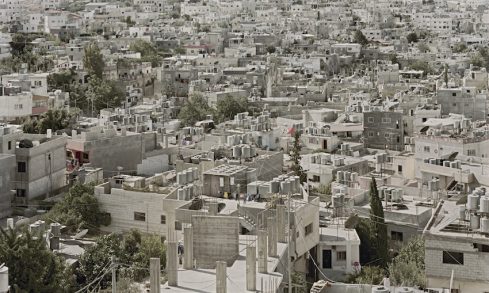
PETTI A., “Spatial Ordering of Exile. The Architecture of Palestinian Refugee Camps”, Crios, Carrocci 1/2013, january-June pp. 62-70
It is the camp and not public space our present and future socio-spatial and political horizon. Refugee camps have been at the center of radical historical transformations that have undermined the political existence of entire communities. Although states and non-governmental organizations have been and are participating actively in conceiving and managing camps, we are still struggling to fully comprehend how the camp form has complicated and transformed the very idea of a city as an organized and functional political community. The birth of the camp thus has the capacity to call into question the very idea of the city as a democratic space. If the political representation of a citizen is to be found in the public space, what is found in the camp is its inverse, the place in which a citizen is stripped of his or her political rights, reduced to bare life. In this sense, the camp represents a sort of anti-city. But what effect does this anti-city produce on the public and political space of the city?
.
.
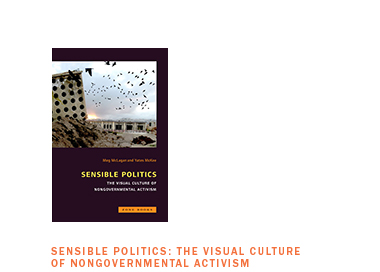
PETTI A., HILAL S. WEIZMAN E., “The Morning After: Profaning Colonial Architecture“, in Sensible Politics: The Visual Culture of Nongovernmental Activism edited by Meg McLagan and Yates McKee
In 2007, after a few years of engaging in spatial research and theory with the conflict over Palestine as our main site of investigation, we decided to shift the mode of our engagement and to establish an architectural collective based on a studio/residency program in Beit Sahour, Bethlehem. DAAR (Decolonizing Architecture Art Residency) seeks to use spatial practice as a form of political intervention and narration. The work of the studio/residency is based on a network of local affiliations and the historical archives we have gathered in our previous work and that we keep on assembling. The residency program has already brought together groups of leading international practitioners—architects, artists, activists, urbanists, filmmakers, and curators—to work collectively within the framework we have set up.
Our practice has had to engage continuously with a complex set of architectural problems centered on one of the most difficult dilemmas of political practice for architects: how to act both propositionally and critically in an environment in which the political force fields, as complex as they may are, are so dramatically skewed. Is intervention at all possible? How could spatial practice within the here and now of the conflict over Palestine negotiate the existence of institutions and of their legal and spatial realities? How can we find an “autonomy of practice” that is both critical and transformative?
![]()
PETTI A., HILAL S. WEIZMAN E.,“Future Archeology”, Afterall, N. 20/2009
.
.
.
Petti, A. Arcipelaghi e enclave, Bruno Mondadori 2007
PETTI, Archipelagos and Enclaves, Routledge 2019
PETTI, A, “An introduction to Archipelagos and enclaves”
.
.
.
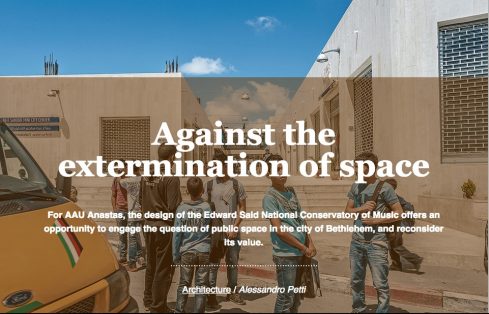
PETTI A., “Against the extermination of space”, in domus N. 970, june 2013
The design of the Edward Said National Conservatory of Music offers an opportunity to engage the question of public space in the city of Bethlehem, and reconsider its value.
Living among the dead, domus 880
Informal urbanism, Alessandro Petti
Petti, A. Wall Architecture, Domus 900, February 2007, pp 85-93
.
.
SB
Having read about the practice of DAAR, one question stays with me: is it possible to intervene?
AP
When one is in a very conflicted and politically unstable situation, this question is even more radicalised than usual. Architects, in particular, should ask themselves how their architectural interventions support certain forms of power, and how they are going to be used. In our situation this is even more complicated, to the point that sometimes it is very diffiult to do any work at all. Maybe I can give you some examples.
.
.
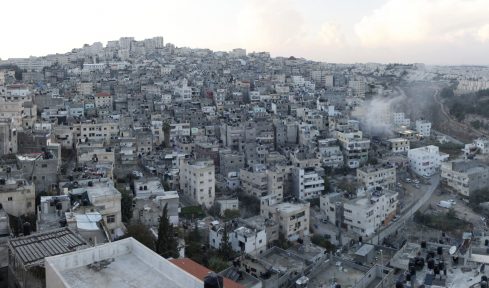
Art & Social Space (08/15/13), “Decolonizing Architecture: Interview with Alessandro Petti” by Ana María Durán
For decades, Palestinian camps have been conceptualized as temporary places. Initially, refugees built only tents. Throughout the years, the latter have been substituted with shelters. As “temporary camps” congeal, they were perceived as politically dangerous: giving up temporality means giving up the right of return. Palestinian refugees were forced into a “suspended life” in order to preserve their right to return to their land. The Palestinian leadership has to rely on the dramatic conditions of refugee camps in order to argue for the urgency of return to the place of origin. This decades-long approach is central to reestablish the right, but has forced refugees to live in an unbearable condition.
.
.
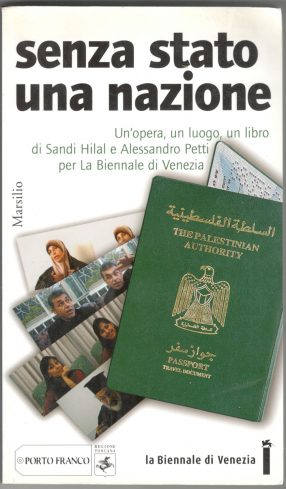
PETTI, A. and HILAL, S. “Senza Stato Una Nazione”, Marsilio 2003 [ITA]
.

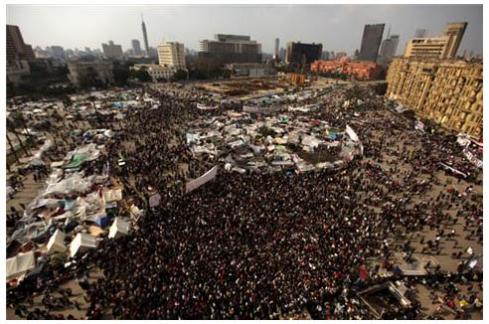
Decolonizing Architecture and civil unrest in Egypt
By Christopher Hawthorne, Los Angeles Times Architecture Critic
February 2, 2011
.
.
“how to inhabit your enemy’s house?”
Article by Lorenzo Pezzani
.
.
PETTI A., HILAL S., WEIZMAN E., The Book of Activism, Conflitti Globali 07, Palestina anno zero
[ITA] La storia non può ridursi a un risarcimento per la geografia perduta. È anche un punto d’osservazione delle ombre, di sé e dell’altro, colte entro un’evoluzione umana più complessa.
Mahmoud Darwish
Frammentazione Il futuro visto da Ramallah Nasser Abourahme; Spazi contigui, tempi differenti Cédric Parizot; Soluzioni (im)possibili. Uno stato, due stati e altre ipotesi Marco Allegra, Paolo Napolitano; Tra Gaza e l’Egitto. Il fantasma di Israele Lorenzo Navone; La costruzione della dipendenza. Acqua, territorio e cittadinanza in Cisgiordania Ilaria Giglioli.
Resistenze Discorsi e pratiche della resistenza popolare Ala Alazzeh; Decolonizing Architecture. The Book of Activism Sandi Hilal, Alessandro Petti, Eyal Weizman; Fatah-Hamas fra radicalizzazione e istituzionalizzazione Paolo Napolitano; Teatri di resistenza Rania Jawad; At-Tuwani. Cronaca di un villaggio sotto scorta Alessandro Doranti; Punti di vista su Gaza Mouin Rabbani, Azmi Bishara, Elena N. Hogan.
Palestina Anno Zero, Conflitti Globali 7
.
.
.
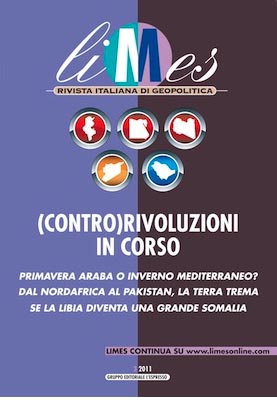
PETTI A., HILAL S. WEIZMAN E., PERIGINI N., “Il limes senza legge“, Limes, 2/2011
[ITA] Gli accordi di Oslo definiscono tre aree di sovranità: israeliana, palestinese e mista. Di fatto, però, se ne è imposta una quarta: il confine stesso. Semplice tratto sulla carta, nella realtà questa striscia di terra è un limbo giuridico.
.
.
.
.
Architectural planning for a different future
Sarah Irving, The Electronic Intifada, 15 July 2010
.
.
Return to Nature, in Extra-Territoriality in the Middle East – Open Anthology, ArteEast Quarterly 12/2009
For the longest time we have thought of extra-territoriality as a designated space or status that lies outside territorial boundaries and either benefits or suffers from the suspension of jurisdiction overruling the national territory. Embassies, refugee camps, and free trade zones are a few cases in point. In recent years, the number and genres of extraterritorial spaces have increased, diversified and consolidated into a dense configuration of exception and exemption that superimpose and perhaps undermine the very notion of territory. What this edition of ArteNews’s quarterly brings to light is the attempt at confining people in a bounded space always instigates a heightened desire to connect across distances and activate new forms of trans-local communication. A territory is no longer (just) a shape but also a complex system of relationships and large-scale structural networks. This issue presents innovative art, video, design and academic practices that analyze and intervene in these contested terrains and their regimes of representation. It is conceived as an open-ended anthology that can grow over time.
With contributions by Francesca Recchia, Anna Wachtmeister, Azad Shekhani, Ehsan Maleki, Ziad Turkey, Lee Wang, Oroub el-Abed, Rana El Nemr, Myriam Abdelaziz, Mona Fawaz, Marwan Ghandour, Sari Hanafi, Ismael Sheikh Hassan, Saba Innab, a-film, Ursula Biemann, Beshara Doumani, Sandi Hilal, Alessandro Petti, Eyal Weizman (Decolonizing Architecture), Ozayr Saloojee, Molly Eagen, Rasha Salti.
Extra-Territoriality in the Middle East – Open Anthology
Guest Editor: Ursula Biemann
.
.
D la repubblica della donne 648/2009
.
.
A+ N. 214/2008 [FRA] (pdf 1,4M)
A+ s’est entretenu avec le ‘decolonizingarchitect’ Alessandro Petti et le philosophe Lieven De Cauter, commissaire de l’exposition à Bozar
A+ N. 214/2008 [NL] (pdf 1,4M)
A+ sprak met ‘decolonizingarchitect’ Alesandro Petti en fi losoof Lieven De Cauter, curator van de tentoonstelling in Bozar
.
.
.
Petti, A., “Temporary Zones; Alternative Spaces or Territories of Social-Spatial Control?,” in Post-it City (Barcelona: CCCB, 2008)
Temporary zones seem to fluctuate continuously between control and freedom, between dominance and resistance. This is an age-old struggle which is countered, on the one hand, by the attempt to conquer spaces of freedom, and, on the other, by the power that always seeks to invade every space. It is hard to say which came first: the free zones that power seeks to occupy, or the power structures that men try to counteract with forms of resistance. What is certain is that, today, both forms use temporality more as an instrument of control than resistance.
.
New leases on life By Yotam Feldman
.
.
Electronic Intifada. Beit Sahour reclaims military base site By Nora Barrows-Friedman
.
.
Bozar Exhibition Visitor Guide (pdf, ~12 Mb)
Decolonizing Architecture presentation (pdf, ~14 Mb)
